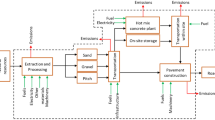Abstract
Purpose
There are methodological questions concerning life cycle assessment (LCA) and carbon footprint evaluation of road pavements, including allocation among co-products or at end-of-life (EOL) recycling. While the development and adoption of a standard methodology for road pavement LCA would assist in transparency and decision making, the impact of the chosen method on the results has not yet been fully explored.
Methods
This paper examines the methodological choices made in UK PAS 2050 and asphalt Pavement Embodied Carbon Tool (asPECT), and reviews the allocation methods available to conduct road pavement LCA. A case study of a UK inter-urban road construction (cradle-to-laid) is presented to indicate the impact of allocation amongst co-products (bitumen and blast furnace slag); a typical UK asphalt production (cradle-to-gate) is modelled to show the influence of allocation at EOL recycling.
Results and discussion
Allocation based on mass is found to consistently lead to the highest figures in all impact categories, believed to be typical for construction materials. Changing from industry chosen allocation methods (Eurobitume, asPECT) to 100 % mass or economic allocation leads to changes in results, which vary across impact categories. This study illustrates how the allocation methods for EOL recycling affect the inventory of a unit process (asphalt production).
Conclusions and recommendations
Sensitivity analysis helps to understand the impact of chosen allocation method and boundary setting on LCA results. This initial work suggests that economic allocation to co-products used as secondary pavement materials may be more appropriate than mass allocation. Allocation at EOL recycling by a substitution method may remain most appropriate, even where the balance of credits between producers and users may be hampered by an inability to confidently predict future recycling rates and methods. In developing sector-specific guidelines, further sensitivity checks are recommended, such as for alternative materials and traffic management during maintenance.



Similar content being viewed by others
Notes
EAF: electric arc furnace; BF: blast furnace; BOF: basic oxygen furnace.
OGV: other goods vehicle (OGV1: 2/3-axle rigid, OGV2: all other OGVs); PSV: public service vehicle; DBM: dense bitumen macadam; HRA: hot rolled asphalt.
References
Classen M, Althaus H-J, Blaser S, Doka G, Jungbluth N, Tuchschimid M (2009) Cast iron ecoinvent LCA data. Life cycle inventories of metals. Final report ecoinvent data v2.1 No.10. Dübendorf: Swiss Centre for Life Cycle Inventories
Birgisdóttir H, Phil KA, Bhander G, Hauschild MZ, Christensen TH (2006) Environmental assessment of roads constructed with and without bottom ash from municipal solid waste incineration. Transport Res D-TR E 11:358–368
BSI (2010) PD 6691: guidance on the use of BS EN 13108 bituminous mixtures—material specifications. British Standards Institution, London
BSI (2011) PAS 2050: specification for the assessment of the life cycle greenhouse gas emissions of goods and services. British Standards Institution, London
Chen C, Habert G, Bouzidi Y, Jullien A, Ventura A (2010) LCA allocation procedure used as an incitative method for waste recycling: an application to mineral additions in concrete. Resour Conserv Recy 54:1231–1240
EAPA (2009) Asphalt in figures 2009. European Asphalt Pavement Association, Brussels
ECRPD (2010) Energy Conservation in Road Pavement Design, Maintenance and Utilisation. Grant Agreement: EIE/06/039/SI2.448265. Intelligent Energy–Europe, Brussels
Ekvall T, Tillman A-M (1997) Open-loop recycling: criteria for allocation procedures. Int J Life Cycle Assess 2:155–162
Eurobitume (2011) Life cycle inventory: bitumen. The European Bitumen Association, Brussels
Feifel S, Walk W, Wursthorn S (2010) LCA, how are you doing today? A snapshot from the 5th German LCA workshop. Int J Life Cycle Assess 15:139–142
Finkbeiner M (2009) Carbon footprinting—opportunities and threats. Int J Life Cycle Assess 4:91–94
Flower D, Sanjayan J (2007) Green house gas emissions due to concrete manufacture. Int J Life Cycle Assess 12:282–288
Frees N (2008) Crediting aluminium recycling in LCA by demand or by disposal. Int J Life Cycle Assess 13:212–218
Frischknecht R (2010) LCI modelling approaches applied on recycling of materials in view of environmental sustainability, risk perception and eco-efficiency. Int J Life Cycle Assess 15:666–671
Hammond G, Jones C (2010) Inventory of Carbon & Energy (ICE). University of Bath, Bath, Annex A: Methodologies for recycling
Huang Y (2007) Life cycle assessment of use of recycled materials in asphalt pavements. PhD, Newcastle University
Keesom W, Unnasch S, Moretta J (2009) Life cycle assessment comparison of North American and imported crudes. Jacobs Consultancy and Life Cycle Associates, Chicago, prepared for Alberta Energy Research Institute—file no: AERI 1747
Langdon D (2008) SPON’S civil engineering and highway works price book 2008. Taylor & Francis, Abingdon
Marceau ML, Nisbet MA, Vangeem MG (2007) Life cycle inventory of Portland Cement Concrete. PCA R&D Serial No. 3011. Portland Cement Association, Skokie
Metal Bulletin (2011) Metal Bulletin Price Book [Online]. Available: http://www.metalbulletin.com/. Accessed 2011
Mroueh U-M, Eskola P, Laine-Ylijoki J (2001) Life-cycle impacts of the use of industrial by-products in road and earth construction. Waste Manage 21:271–277
Nicholson AL, Olivetti EA, Gregory JR, Field FR, Kirchain RE (2009) End-of-life LCA allocation methods: open loop recycling impacts on robustness of material selection decisions. In: 2009. IEEE International Symposium on Sustainable Systems and Technology
Santero NJ, Masanet E, Horvath A (2011a) Life-cycle assessment of pavements. Part I: critical review. Resour Conserv Recy 55:801–809
Santero NJ, Masanet E, Horvath A (2011b) Life-cycle assessment of pavements, part II: filling the research gaps. Resour Conserv Recy 55:810–818
Sayagh S, Ventura A, Hoang T, François D, Jullien A (2010) Sensitivity of the LCA allocation procedure for BFS recycled into pavement structures. Resour Conserv Recy 54:348–358
Sinden G (2009) The contribution of PAS 2050 to the evolution of international greenhouse gas emission standards. Int J Life Cycle Assess 14:195–203
Spielmann M, Scholz R (2005) Life cycle inventories of transport services: background data for freight transport. Int J Life Cycle Assess 10:85–94
Stripple H (2001) Life cycle assessment of road—a pilot study for inventory analysis. Swedish Environmental Research Institute (IVL), Gothenburg
The Concrete Centre (2009) The concrete industry sustainability performance report—1st report. The Concrete Centre, Surrey
Vogtländer J, Brezet H, Hendriks C (2001) Allocation in recycling systems. Int J Life Cycle Assess 6:344–355
Wang M, Lee H, Molburg J (2004) Allocation of energy use in petroleum refineries to petroleum products. Int J Life Cycle Assess 9:34–44
Wayman M, Schiavi-Mellor I, Cordell B (2011) Protocol for the calculation of whole life cycle greenhouse gas emissions generated by asphalt—part of the asphalt Pavement Embodied Carbon Tool (asPECT). Transport Research Laboratory, Crowthorne
World Steel Association (2008) Application of the worldsteel LCI data to recycling scenarios—worldsteel recycling methodology. World Steel Association, Brussels
Acknowledgments
This study was partly funded from an Engineering and Physical Sciences Research Council (EPSRC) Platform Grant in Pavement and Railtrack Engineering and the Road Surface Treatment Association. The authors would like to thank staff at Lincolnshire County Council for providing data for the case study.
Author information
Authors and Affiliations
Corresponding author
Additional information
Responsible editor: Wulf-Peter Schmidt
Rights and permissions
About this article
Cite this article
Huang, Y., Spray, A. & Parry, T. Sensitivity analysis of methodological choices in road pavement LCA. Int J Life Cycle Assess 18, 93–101 (2013). https://doi.org/10.1007/s11367-012-0450-7
Received:
Accepted:
Published:
Issue Date:
DOI: https://doi.org/10.1007/s11367-012-0450-7




